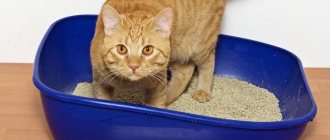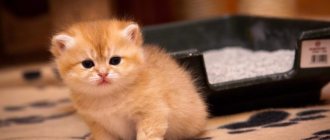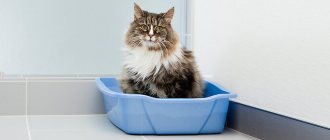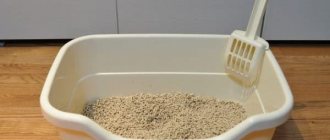The appearance of a kitten in the house is not only a pleasant chore. After all, a new family member needs to be correctly named, housed and toilet trained. It is at this last point that the most problems arise. And it’s not at all about the complex nature of cats.
To teach a kitten to go to the litter box, the owner needs to find out at what age this is done, how to choose a litter and many other subtleties.
At what age does training begin?
The right recommendations will help speed up the long process. Kittens are also children, so there is no certain age for litter box training to be easy and quick. You can force an animal to go potty at 2 months or after 3 months - it depends on its intelligence and learning ability.
If a baby lives with a mother cat, he copies her behavior. The two-month-old kitten is already coping with the task on his own. If the mother is not nearby, the owner can train the cat to use the litter box.
It is not difficult to train a kitten to use the toilet in an apartment, especially when there is a cat nearby, even at 1 month, if the pet is smart. It’s not too late to do this even at 3 months.
Step-by-step instruction
Time to move on to the basic instructions, by following which you can teach your kitten a new, very useful habit - going to the toilet in the tray.
- Place the litter in a quiet and secluded area of your home. This should not be a passage or corridor, or areas near doors where people often walk. The ideal place is a bathroom or toilet, which is always open and the cat has access to the litter around the clock.
- The best time for the first trip to the new toilet will be 20-40 minutes after the kitten eats. Take it and place it with its paws directly into the tray with the filler.
- Pet him, say something kind, and then move away and let him look around and sniff the new place.
- If the kitten is ready, it will do all the necessary things. After the procedure is completely completed, praise him and cover the waste with a fresh layer of filler. Disposal of waste should not be done due to the importance of the smell of waste in the toilet area. Cats sense this smell and it is easier for them to find a place to go to the toilet. However, you cannot leave the toilet completely untouched. Kittens and adult cats are very picky about cleanliness and will not go into a dirty litter box.
Important!
Don't be too aggressive with the kitten. If you are unable to train him to use the litter box and he goes to the toilet in the wrong places, you should show him your dissatisfaction, but in an extremely friendly manner. At the moment of a mistake, go up to the kitten, lightly tap his nose with your finger and tell him what he is wrong about (this is how cats let their kittens know that they are wrong). And then take him to the tray and gently explain that this is where he needs to go to the toilet.
If the cat went past the toilet more than an hour ago, do not scold him, this will cause him misunderstanding. He won't remember what he did wrong. It is necessary to make it clear in a timely manner about the mistake made, but as we wrote above, do this in an extremely friendly manner - without shouting or physical violence.
Choosing a litter box for a kitten
An incorrectly selected tray is one of the first factors that will prevent you from teaching a small kitten to order. Below we consider the types of devices:
- open without mesh;
- open with mesh;
- tray-house;
- self-cleaning.
The correct tray for a cat is wide and with high sides. This is a general requirement for each type.
Open without mesh
A tray without a mesh will not have to be washed every day, and the animal will not injure its paws while trying to dig. But not every type of litter is suitable for it: the cat will carry it around the apartment and scatter it around the tray.
Open with mesh
More complex design. A net is installed on the container where the animal sits. Costs more, but is more hygienic. You can put any filler into the tray; it is inaccessible to the cat.
There are disadvantages:
- The mesh needs to be washed daily.
- The baby will still scratch the surface and may injure his paws.
The main disadvantage of both types of trays is their openness, which makes it more difficult to train a kitten to go to the toilet.
Tray house
An excellent choice for a small living space. It can be placed in the bathroom or hallway. It’s not difficult to make it yourself: the main thing is not to forget about the removable lid to make it convenient to clean. With or without mesh – the owner’s choice.
Important: You can buy an ordinary tray and make a tall, lightweight lid yourself.
Self-cleaning
Premium category trays. Almost no owner intervention is required. Simple models are equipped with a rake for leveling the filler and removing used lumps, a carbon filter to eliminate odors, and a silent motor with which this design operates.
The most expensive models require a constant connection to the network and sewerage.
Why does the cat walk past the litter box?
There are times when a kitten or even an adult cat comes to the litter box, but goes to the toilet next to the litter box.
Main reasons:
- The kitten doesn't like the litter. It has an unpleasant odor, it can be either chemical or the smell of waste.
- If you don’t like the smell of the litter box itself, you may have washed it with a chemical or chlorine, which the kitten does not tolerate.
- The sides of the tray are too high and it is uncomfortable for the kitten to jump so high. The toilet must be accessible.
- Well, the kitten may simply be very young and not understand how to go to the toilet correctly. Continue training and over time his behavior will improve.
Eliminate the reasons, this should help. If not, contact your veterinarian; perhaps something is bothering the kitten.
Filler selection
The filler is selected under the tray.
Important: cats do not like scented toilet granules, so using them will not give the desired results.
clumping
Available with or without flavoring. The clumping product is hygienic and easily absorbs moisture and unpleasant odors. The main rule of any litter: the smaller the kitten, the smaller the granules.
Zeolite
Zeolite filler is more expensive than wood filler, but is consumed more economically and absorbs moisture better. It does not stick to the kitten’s paws or fur if a special mat is placed under the tray.
Woody
Cats can taste the litter. The safest option in this case is wood. But without a special rug, the kitten will carry it around the apartment on its paws.
Grain and pulp
Both types are environmentally friendly, relatively inexpensive and made from organic substances. If the kitten accidentally swallows particles of the filler, it’s not scary. Grain and pulp products clump easily.
Silica gel (hazardous to animals if eaten)
One of the most expensive types. This is a substance that is placed in boxes with shoes and bags to absorb moisture and odors. The silica gel filler does not stick to the kitten's fur and paws and does not create a stench, but if there is too much water in the tray, a puddle may form.
It is best to place this litter under the net so that the kitten does not accidentally eat it.
No filler
Need a self-cleaning tray. There is no point in giving up filler in a conventional device. All problems can be solved in other ways:
- spreads on its paws - buy a special mat, then all the granules will remain on it;
- refuses to use - most likely, the kitten does not like litter with a smell or too hard granules;
- better than newspapers - printing houses use toxic ink, the fumes of which are dangerous;
- expensive - the cheapest filler is wood.
Create ideal conditions
In order for the kitten to quickly get used to its new toilet, it is necessary to clean it thoroughly .
This should be done as often as possible. A dirty litter tray is unlikely to attract an animal. The kitten will look for a cleaner place. If you use clumping litter, the used composition should be removed with a spatula and thrown into a bag. It's better to tie it right away. In the first weeks, you can leave feces in the cat's litter box. This will speed up the addiction process.
All filler in the tray must be changed regularly . This should be done at least once a week. In this case, the cat litter box must be washed thoroughly. You should not use toxic detergents. It is enough to use a soap solution. The tray must be dried after cleaning and washing. Only after this can it be filled with fresh product.
If the kitten has gone past the litter box, then this area must be carefully treated to eliminate odors. Otherwise, the incident will repeat.
The process of training a kitten to the tray
Be patient to finish what you start.
Important: Light massage stimulates digestion and the bowel movement reflex; When you sit the kitten on the potty, you can stroke its tummy.
Stage one - getting to know each other
For the first time, they put the kitten in the tray several times, take his paw and help him “dig.” Let the baby not be afraid to sniff the pot and the filler: this way he will get used to the place.
Stage two – observation and assistance
It is possible that you will have to run after the kitten throughout the apartment and watch when it starts meowing loudly, squatting, spinning in one place and scratching its paw on the floor.
Then you need to immediately carry him to the tray and not let him go until he goes to the toilet.
It will not be possible to correct the situation in 1 day, but if everything is done correctly, the cat will definitely get used to it.
Stage three - strengthening the reflex
Now the kitten can be scolded for ignoring the toilet. But not too much. When cleaning up after your baby, you just need to throw everything in the litter tray and take the kitten there when he starts looking for a place to go to the toilet. This must be done without shouting.
Additional tips and tricks
- You cannot hit a kitten or poke its face into the dirt;
- the optimal layer of filler in the tray is 5 cm;
- if the breeder’s baby was constantly lying on moisture-absorbing diapers, you will have to be patient;
- The kitten should also be praised for small progress.
Common Mistakes
- Wrong size of granules: the smaller the kitten, the smaller they should be;
- too early or late litter box training;
- If the baby relieves himself on soft surfaces, you need to put a piece of cloth in the filler.
How to train an adult animal: algorithm of actions
Adult felines are very scrupulous and picky about the toilet. They are disturbed by noise and various external stimuli. To fulfill their natural needs, they instinctively choose hard-to-reach, secluded corners, for example, places behind a closet or behind a sofa, where it is quiet and there are no prying eyes. Therefore, while the animal adapts, it is better to play it safe and block off such areas.
There is no difference in learning ability between male and female cats, especially for sterilized pets.
When working with an animal, you should take into account that each pet has its own character and level of intelligence. Some people learn to use the litter box fairly quickly, while others need time to form the desired habit. Difficulties usually arise when training adult pets - especially if the cat came into the house from the street, where there were no rules for the discharge of natural needs.
To develop the necessary skill in your pet, you need to place the cat litter box correctly. It should always be available and located in a convenient location. A bathroom or a warm loggia are the most suitable options.
The animal must be explained what a tray is and for what purposes it is used. This must be done patiently and calmly, without getting irritated, much less without any physical influence. Cats are very smart creatures; they respond well to changes in voice intonation. Take advantage of this. Barbaric methods like poking your nose into a puddle will not speed up the learning process, but, on the contrary, will complicate the task, increase the duration of adaptation and turn your pet into a frightened creature.
A scheme for training an adult cat to use a tray to obtain the fastest results may look like this:
- The need to relieve oneself in animals usually occurs after eating. For the first time after a cat appears in the house, do not leave it unattended. When the animal has eaten, carefully take it to the tray. Sit near the cat, wait. When she relieves herself, praise and pet her. But don’t rush to clean the litter box – let your pet form an olfactory connection.
- The animal may want to go to the toilet not immediately after a meal, but at another time. Signs of this are as follows: the animal begins to worry, sniffs corners, and scratches the floor. In this case, you need to take the pet to the litter box, wait until everything is over, and praise it.
- If it happens that you didn’t notice and the cat did its “dark” business in the room, then do not rush to punish it. Blot the puddle with a napkin and take it to the tray. Let your pet smell it. If the cat came into the house from the street, sprinkle the puddle it made with sand and take the wet sand to the tray. Give your pet a chance to explore the litter box and form an olfactory connection. The place where the puddle was must be washed with perfume or strong-smelling substances: vinegar, alcohol, kerosene. You can drop and rub a couple of drops of essential oil with the aroma of citrus or lavender on the washed area.
- It happens that the pet himself chose a place for the toilet, and it does not coincide with where the tray is located. In this situation, there is only one way out - put the tray in the place that the cat chose. Once the habit is established, begin to gradually move the tray so that over time it ends up in the place you want. The movements need to be made small: 1-2 centimeters per day.
- Don't take risks and don't leave outdoor shoes in the access area. The smells of the street can provoke the animal, and it will be very difficult for you to rid your favorite shoes of cat odors.
- If another cat previously lived in the house, treat the area where her litter box was located with a strong-smelling compound. Cats' sense of smell is unique. A new resident may be able to smell the scent even if several years have passed and will be tempted to mark the area.
- In pet stores you can purchase a special spray for toilet training a cat, which is recommended for treating the litter box. There are also sprays with a repellent odor, which are recommended for treating risk areas, such as the hallway.
If the cat knows where the tray is, but periodically goes to another place, you need to take a good look and look for the reason. Perhaps something is bothering your pet.
Possible difficulties
If all the recommendations are followed, and the kitten does not go to the litter box, do not despair.
Pet doesn't go into litter box
You need to buy a device that is larger, wider, with higher sides, and it will become easier to teach your cat to go to the litter box.
Pet ignores litter box
If the baby goes to the toilet everywhere, check that the rules for choosing the device, filler and place for the tray are followed. If an already accustomed kitten is mischievous, the advice is the same:
- the tray should be without traumatic elements, preferably without a mesh;
- filler – odorless;
- put it in a dark, secluded place so that the animal is not afraid of anyone.
If the recommendations are taken into account, the pet will be able to go to the toilet where it needs to be. The exception would be a kitten that is too small. A one-month-old baby will not understand what they want from him.
How to choose the right tray
It is important to properly equip your cat's litter box: an unsuccessful tray or litter will ruin all your efforts.
Choose a quality product made from durable plastic: cheap ones absorb odors and are difficult to clean well. A squeamish cat will refuse to go to the litter box if it does not seem clean enough to her. In addition, the smell of cheap plastic, even indistinguishable to humans, can be unpleasant to animals. Reliability also leaves much to be desired: if the container breaks quickly, you will have to get used to a new one.
Make sure the device is comfortable to use. The height of the sides does not interfere with entry and exit, and the width is sufficient for the animal to fit in the tray. It is best for a kitten to use a litter tray for growing up, including to avoid the need to retrain it.
Is it possible to train a baby to use the toilet of another cat?
Smell is the main safety criterion for cats. The kitten will not use someone else's potty. In this case, even neutral flavors will not help accustom the cat to the litter box.
In order for the baby to learn to use a device that has already been used, the tray must be disinfected and make sure that foreign odors have disappeared.
Toilet training
If home conditions do not allow for space for a litter box, you can train your cat to use the toilet in a different way. The process will take a long time: it will take 1-2 months. To accustom a kitten to the toilet, the tray is carried to it and raised little by little.
When the devices are at the same level, do this:
- the tray is placed on the lowered lid of the plumbing for 5-6 days;
- pour a little litter into the toilet and place the kitten on it;
- To prevent the animal from being scared, you can buy a special attachment.
Litter training a kitten is an important element of upbringing. You can’t do without this skill in an apartment. The owner will need to show will and perseverance. A Persian, a handsome British cat or a cat without a pedigree will learn everything if you don’t hit the baby or yell at him.
Use toys, treats and praise
The goal is to help your cat create a positive association with her litter box. To do this, you can use anything your cat likes, be it a tasty treat, a favorite toy, or catnip. Place toys around the new tray. Scatter treats in the area with her litter box. Sprinkle catnip near the entrance of the box or on the rug.
© shutterstock
You should also provide positive reinforcement whenever your cat approaches and explores a new litter box. Give her a treat so she knows she's doing the right thing. This way, she can use the litter box to get treats or play with her favorite toys and will be more likely to use it in the future.
When rewarding your kitten for good behavior, warm positive emotions work just as well as treats. Praising and supporting your cat lets it know that you approve of its behavior. With your reassurance, she will feel better about using the new litter box.
Additionally, you should never force your cat to use a new litter box or scold her if she doesn't. Negative reinforcement doesn't work; this will only make your cat afraid of the new box and you. Give your cat time and support to get used to the new litter box.
Changing your cat's litter box can be quite a task. Kittens tend to be resistant to change, and if you're not careful, you could end up with more of a mess than before.
By placing the box in the same place and using treats, smells and praise to encourage her, you can ease her transition. With these four helpful tips, you now know how to give your cat a new litter box. Good luck!











